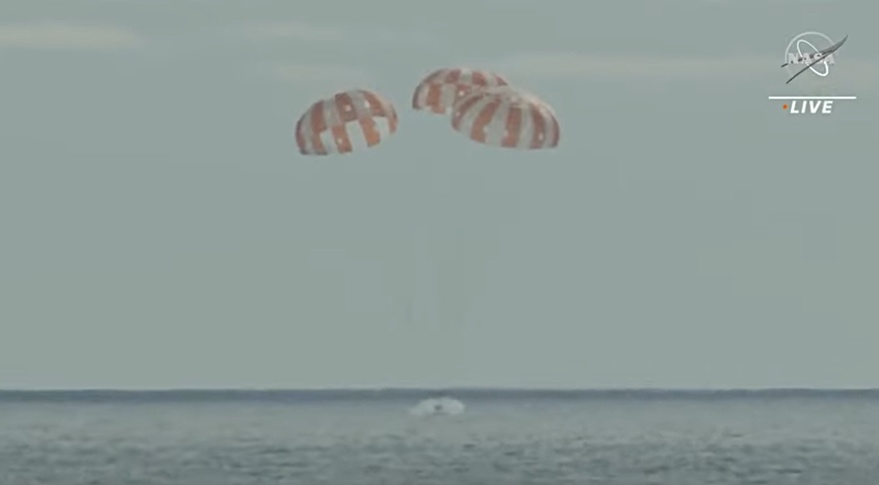WASHINGTON — Fifty years to the day after the last Apollo moon mission touched down on the lunar surface, NASA’s plans to return to the moon took a major step forward with the successful splashdown of the Orion spacecraft to end the Artemis 1 mission.
The Orion spacecraft splashed down off the coast of Baja California at 12:40 p.m. Eastern Dec. 11, ending the 25.5-day Artemis 1 uncrewed test flight. The splashdown took place near recovery forces led by the USS Portland, which will haul the capsule onto the ship to transport back to the port of San Diego, California.
After the European Service Module separated at 12:00 p.m. Eastern, the Orion crew capsule performed a “skip” reentry, descending first to an altitude of about 60 kilometers, then ascending to about 90 kilometers before completing the rest of descent. That maneuver is designed to reduce g-forces on the spacecraft and allows more flexibility in selecting a landing site.
Successfully completing reentry at lunar return velocities of up to 40,000 kilometers per hour was the top objective of the Artemis 1 mission, since there was no other way to test the spacecraft’s thermal protection system. “There is no arcjet or aerothermal facility here on Earth of replicating hypersonic reentry with a heat shield of this size,” said Mike Sarafin, NASA Artemis 1 mission manager, at a Dec. 8 briefing.
“It is a safety-critical piece of equipment. It is designed to protect the spacecraft and the passengers, the astronauts on board,” he said. “So the heat shield needs to work.”
After splashdown, NASA planned to leave the capsule in the water and powered on for two hours to conduct a “soakback” test to see how the capsule handled the heat from reentry. Teams will then use boats to tow the capsule into the well deck of the USS Portland, where it will be secured in a cradle and the deck drained before heading to San Diego.
The splashdown concluded a long-delayed mission that started with a launch on the first flight of the Space Launch System Nov. 16 from the Kennedy Space Center in Florida. This was the second time the Orion capsule flew in space, after the brief Exploration Flight Test 1 orbital mission in December 2014, but the first to feature the full Orion spacecraft that included the European Service Module.
Orion flew by the moon Nov. 21, passing about 130 kilometers above the surface as it performed a maneuver to send the spacecraft towards a distant retrograde orbit around the moon. Orion entered that orbit Nov. 25, departing Dec. 1 and performing another lunar flyby and maneuver Dec. 5 that put the spacecraft on course back to Earth.
The splashdown took place 50 years to the day after Apollo 11’s Lunar Module touched down in the Taurus-Littrow region of the moon on the sixth and final Apollo lunar landing mission. No humans have been beyond low Earth orbit since the conclusion of that mission.
Sarafin, at the Dec. 8 briefing, noted Artemis 1 was the 65th mission supporting human spaceflight he had been involved with. “I love flight testing,” he said when asked to compare Artemis 1 with Apollo 17. “The first time you do anything is harder than a repeat.”
“Firsts are harder, because you don’t know what you don’t know,” he said. “But as you get to more and more challenging missions, like Apollo 17, that becomes a harder question to answer.”
“Artemis 1 is a test flight,” added Jim Geffre, Orion vehicle integration manager. “You learn things that you didn’t anticipate.”
The first crewed Orion mission, Artemis 2, is projected to take place no earlier than late 2024. It will take four astronauts, including one from the Canadian Space Agency, on a flight around the moon and back.
